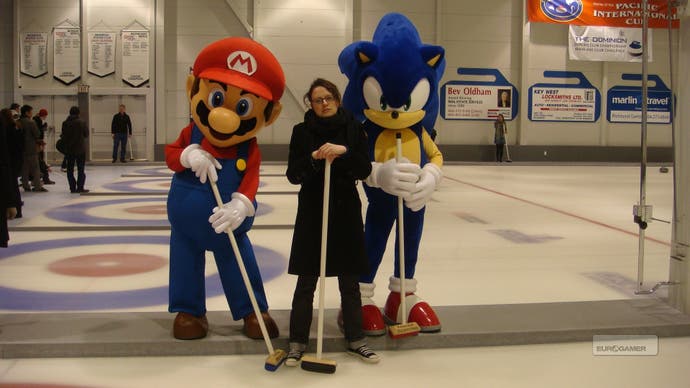Mario & Sonic at the Olympic Winter Games
Rings a bell.
In November 2007, the first ever videogame starring Mario and Sonic appeared on shop shelves. It was a huge hit, despite being a bit 7/10, so it didn't come as much of a surprise when SEGA and Nintendo announced a sequel.
But with years to go until the next Olympics (we're sorry in advance), what would the next Mario & Sonic title be about? Perhaps SEGA and Nintendo would adopt the tried and trusted strategy employed by so many of today's successful publishers and rip off someone else's idea. Why not set the game in a post-apocalyptic American city? Or, how about Mario Gear Solid: Sonic of Liberty? Who wouldn't want to play, say, Mario & Sonic of War?
Alternatively, why not come up with something totally fresh and new like Mario & Sonic Fight to the Death, Mario & Sonic Explore their Sexuality, or Mario & Sonic Bring Peace to the Middle-East? Because that would be weird and stupid. But also because fresh and new doesn't sell half as well as old and familiar, most of the time anyway. And so here comes that sequel: Mario & Sonic at the Olympic Winter Games.
Cynics might assume all they've done is slap an extra word on the box, throw in some new mini-games, add a couple more characters and cover everything with a fresh blanket of virtual snow. Well, Mr Cynics, it's true they've done that, but they've also addressed some of the issues with the previous game. Plus, they've managed to make this Mario & Sonic more like ye olde video-gaymes of yesteryear, with proper objectives and skill requirements and rewards, while simultaneously making it more accessible. An impressive feat, so how's it been done?

Let's start with those new mini-games. Highlights include a variety of snowboarding and skiing efforts, where you tilt the remote to steer your character down mountains, through slalom gates and round half-pipes. You can attach a nunchuk and use the controllers like a set of ski poles, but all the mini-games can be played with the remote alone.
The advantage of this is twofold. First off, you don't need to invest in a load of nunchuks to enjoy the full multiplayer experience. Secondly, you don't end up inadvertently and repeatedly whipping yourself in the groin as with Namco Bandai's enjoyable but painful Wii offering, Communal Crotch Flaying.
The remote works fine on its own. The controls are responsive, with little lag and the level of sensitivity is just right, so it's easy to get back on track when you over-steer or veer off course. However, it does all feel a bit simplistic. There's not much subtlety involved and there's never a sense of having as much precise control as when, say, driving round a Mario Kart circuit. So why not throw in Wii MotionPlus functionality? Surely this is the kind of thing that technology was made for?

According to SEGA, the aim of leaving it out was to make the game as accessible as possible. In other words, to keep the controls simple and avoid making potential purchasers think they've also got to buy a load of peripherals to enjoy the game fully. Which is reasonable enough, but you can't help wishing they'd also chucked in an option for the huge number of Wii owners who have picked up one or two MotionPlus add-ons anyway.
At least there's the option to hook up a Wii balance board. As with the Family Ski titles, you stand on the board and shift your weight left and right to steer. Once again the controls are responsive and using the board does add something to the whole experience, certainly for those who get to watch you squat and wobble around like a tit. But once again, there's a slight lack of precision and subtlety. In short, having a board adds novelty value but is in no way essential to enjoying MSOWG.









